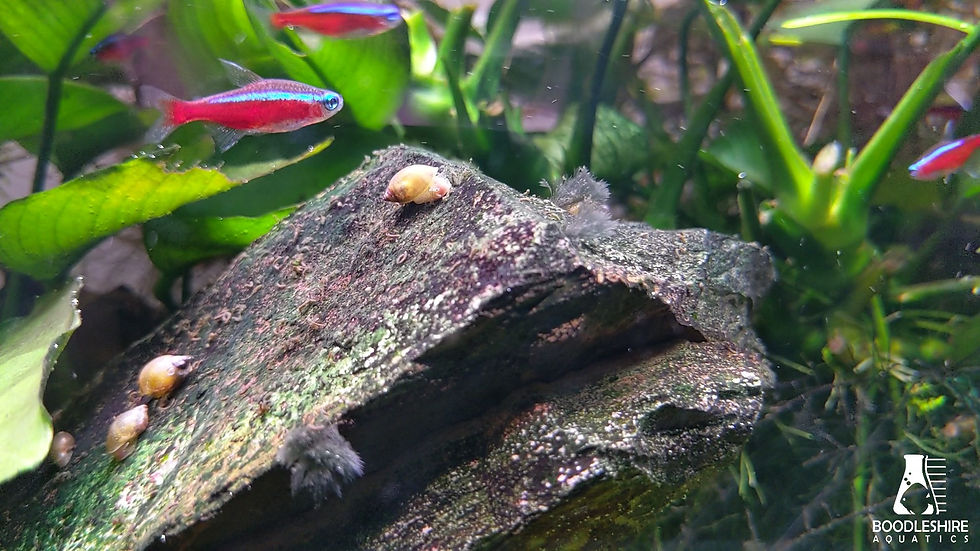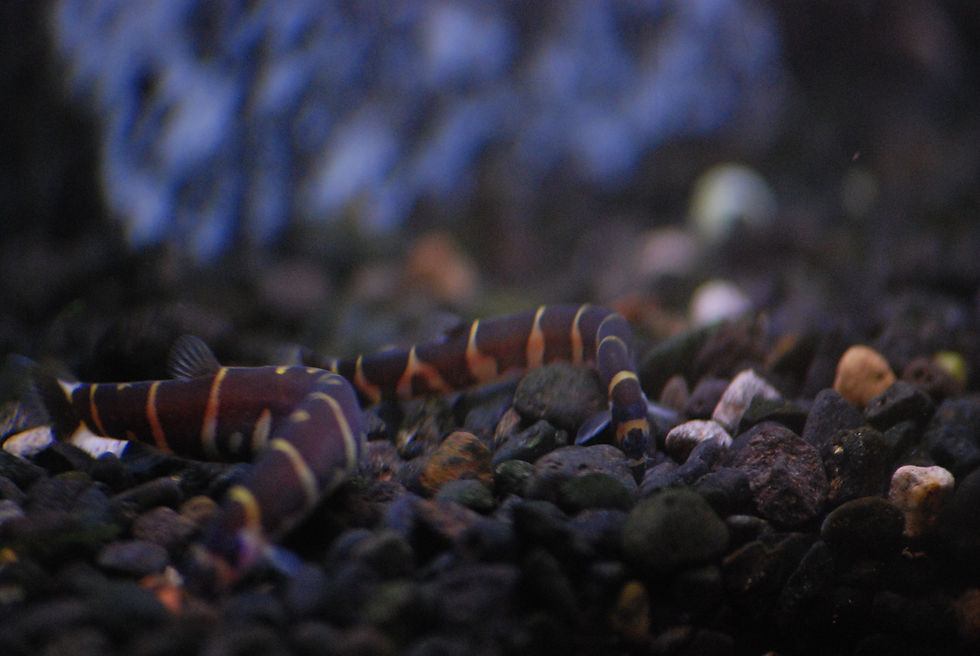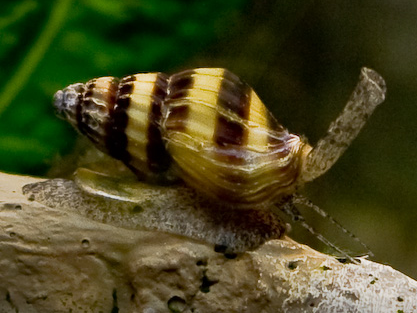How to Resolve an Aquarium Snail Infestation.
- Brian Blake

- Dec 20, 2021
- 5 min read
Updated: Mar 25, 2022

The definition of an infestation when it comes to aquarium snails is relative to the individual. I, for example, have between 25 and 50 tiny bladder snails in my high tech planted at any given time. I don’t consider this an infestation because their population remains under control from predation, and they benefit my tank by consuming various alga.
So let's define a few terms here. First, a hitchhiker is a snail you did not intend to add to your aquarium. Hitchhikers can enter your system as eggs, juveniles, or adults on plants or filter media. A nuisance snail usually starts as a hitchhiker coupled with the fact you don’t want it in your tank. An infestation results from a nuisance snail whose population has gotten out of control.
Before you set off the alarm and break the glass case with the snail poison in it, ask yourself if you really have an infestation. Can the population be controlled? Snail eggs are highly nutritious and easy pickings, therefore, most fish will consume them. This controls the snail population over time. It will still fluctuate, but shouldn’t exceed a range depending on how heavy the predation is. More predators + more eggs = a higher number of eggs consumed.
Also ask yourself, are the snails a benefit, neutral or a hindrance? Do they consume algae or detritus? Or are they just an eye sore before they die off and raise nutrient levels? If your snails population is not controlled by predation, and they are ultimately a hindrance to your tank, then you’ve got an infestation by most standards. Let’s go over what you can do to resolve it.
Which Species are You Dealing With?
It is important to identify the species of snail infesting your tank. Snails vary widely in their biology and lifecycles. Some are hermaphroditic, others are bisexual. Some species give birth to live young, while others lay eggs above and below the water line. Some eggs are soft and jelly-like, others are hard and more difficult to consume. The biology and lifecycle of your species will determine who you control the infestation, and what methods are most effective.
The Long Haul
The method of removing snails and their eggs by hand is the most meticulous and time consuming. However, it is also the least intrusive. Utilizing this method prevents the addition of more fish and chemicals to your tank.
Begin by determining if your snail lays eggs and if they do, where and what they look like. You’ll get pretty good at spotting them after a while. Bladder and ramshorn snails lay jelly-like balls of around a dozen eggs on plants, decor, and the glass. Some snails like Malaysian trumpet snails, produce live young and don’t lay eggs at all. In this case, removing excess food and debris will help limit their population, although this is true for any nuisance snail.
As you perform your maintenance or whenever you see eggs or an adult, remove them from the tank. This habit translates to you as the predator. Consistent removal of the snails, their eggs, and their food, will eventually reduce the population to an unsustainable number. At this point they will no longer reproduce fast enough to maintain a population and will completely die off from over-predation.
Snail Trap
Instead of the removal of individual snails, one by one, try using a snail trap. There are plenty of commercially available options, or you can easily make your own snail trap using a food safe container. Drill or puncture holes of varying size into the container. Make sure the holes are large enough to allow the snails you're trying to capture, but not so large that fish swim in. Place into the container some bait. You can use algae pellets or wafers, but I recommend cucumber or zucchini as they will not dissolve in the water and are therefore much cleaner.
Place the trap into the tank at night just before the lights go off. In the morning, remove the trap and discard any snails it trapped. Do not throw snails outside or down a drain. This is how infestations of local water sources happen.
Predators
Adding a snail predating fish to your aquarium automates the manual snail removal process described above. Instead of your meticulous culling of snails and eggs, the predatory fish you have added will do it for you.
Most omnivorous species of fish will consume snail eggs as they are highly nutritious, easily digestible, and unprotected prey. This may reduce the population somewhat, but as these species are not actively seeking snails to consume, the population may remain relatively unchanged.

Species of fish that specifically hunt and consume snails as one of their main prey types are particularly adept at controlling snail populations. Loaches, for example, evolved to sift through the substrate and turn up snails and their eggs. Botia and clown loaches for large tanks, and kuhli loaches for small tanks, will actively seek out and prey on snails. Utilizing these types of predators is how you most effectively reduce snail populations through predation.

In addition to fish, another popular option for snail predators is the assassin snail, Clea helena. When kept in groups of 5 or 6, this carnivorous snail will bury itself in the sand and predate on fish and snail eggs, smaller snails, and carrion. They are not hermaphroditic and slow to reproduce so their is a low chance of them becoming pests themselves. They prefer around a neutral pH and medium water hardness.
Copper
As a last resort, you can use a copper sulfate solution to kill snails. Copper sulfate is highly toxic to all invertebrates and moderately toxic to most plants and some fish. If you have any delicate fish like discus or saltwater angels, or delicate plants like Sagittaria or Vallisneria, or any invertebrates at all, do not use copper to treat a snail infestation.
If you have hardier fish and thicker plants like Anubias, and no other invertebrates, including coral, and you want to use copper sulfate, the recommended dose is .39 ppm or 0.39 mg/L. This will kill about 50% of your snail population in one week. Maintain this dose for two weeks to kill the entire population. This concentration isn’t toxic to fish or hardier plants.
Do not increase the dose to kill the snails faster. A higher dose will become toxic to fish and will begin to kill off even the hardier species. Be sure to remove snails as they die off. If they are not removed, they will decompose and cause toxic nutrient spikes.
After the infestation is treated, perform several water changes to reduce the copper concentration significantly. Purchase a copper test kit and perform 25 % water changes every two days until copper reaches below the .25 ppm mark.
To remove the remaining copper, add activated carbon to your filtration system and dose your tank with humic acid. The humic acid will bind to metals such as copper and increase their adsorption by the carbon. Humic acid solutions designed for the removal of metals are commercially available from aquarium hobby retailers.
An Ounce of Prevention
To prevent an infestation, treat everything before you add it to your tank. If the item is brand new and dry, like a piece of driftwood from the shelf, you don’t need to do anything. If you are adding plants from another aquarium, soak them in cold, chlorinated water for 30 minutes, and complete a visual inspection for eggs and adult snails before adding them.
If you're adding filter media to seed your aquarium with beneficial bacteria, don’t soak it in chlorinated water, that will kill the bacteria as well. Instead, do a visual inspection to the best of your ability.
Photos
https://commons.wikimedia.org/wiki/File:Kuhli_loaches.jpg
https://commons.wikimedia.org/wiki/File:Clea_helena.png




Comments